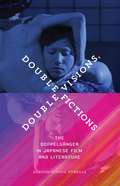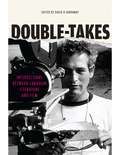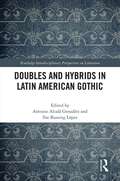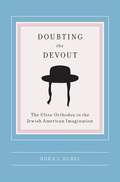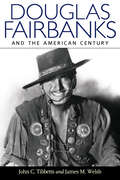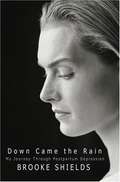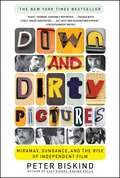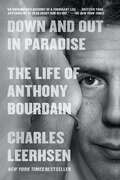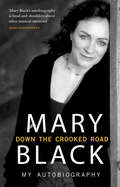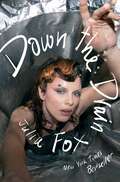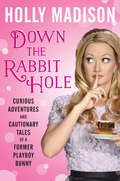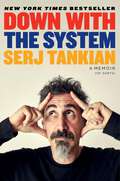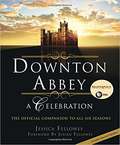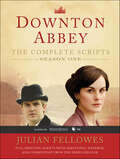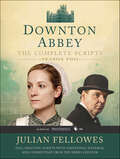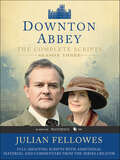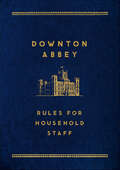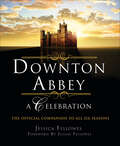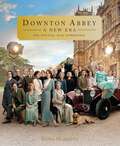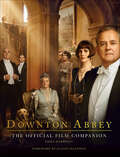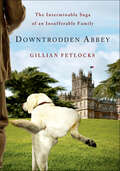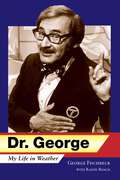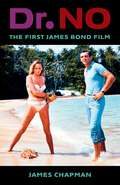- Table View
- List View
Double Visions, Double Fictions: The Doppelgänger in Japanese Film and Literature
by Baryon Tensor PosadasA fresh take on the dopplegänger and its place in Japanese film and literature—past and present Since its earliest known use in German Romanticism in the late 1700s, the word Doppelgänger (double-walker) can be found throughout a vast array of literature, culture, and media. This motif of doubling can also be seen traversing historical and cultural boundaries. Double Visions, Double Fictions analyzes the myriad manifestations of the doppelgänger in Japanese literary and cinematic texts at two historical junctures: the interwar period of the 1920s and 1930s and the present day. According to author Baryon Tensor Posadas, the doppelgänger marks the intersection of the historical impact of psychoanalytic theory, the genre of detective fiction in Japan, early Japanese cinema, and the cultural production of Japanese colonialism. He examines the doppelgänger&’s appearance in the works of Edogawa Rampo, Tanizaki Jun&’ichiro, and Akutagawa Ryunosuke, as well as the films of Tsukamoto Shin&’ya and Kurosawa Kiyoshi, not only as a recurrent motif but also as a critical practice of concepts. Following these explorations, Posadas asks: What were the social, political, and material conditions that mobilized the desire for the doppelgänger? And how does the dopplegänger capture social transformations taking place at these historical moments?Double Visions, Double Fictions ultimately reveals how the doppelgänger motif provides a fascinating new backdrop for understanding the enmeshment of past and present.
Double-Takes: Intersections between Canadian Literature and Film (Reappraisals: Canadian Writers)
by David R. JarrawayOver the past forty years, Canadian literature has found its way to the silver screen with increasing regularity. Beginning with the adaptation of Margaret Laurence’s A Jest of God to the Hollywood film Rachel, Rachel in 1966, Canadian writing would appear to have found a doubly successful life for itself at the movies: from the critically acclaimed Kamouraska and The Apprenticeship of Duddy Kravitz in the 1970s through to the award-winning Love and Human Remains and The English Patient in the 1990s. With the more recent notoriety surrounding the Oscar-nominated Away from Her, and the screen appearances of The Stone Angel and Fugitive Pieces, this seems like an appropriate time for a collection of essays to reflect on the intersection between literary publication in Canada, and its various screen transformations. This volume discusses and debates several double-edged issues: the extent to which the literary artefact extends its artfulness to the film artefact, the degree to which literary communities stand to gain (or lose) in contact with film communities, and perhaps most of all, the measure by which a viable relation between fiction and film can be said to exist in Canada, and where that double-life precisely manifests itself, if at all. - This book is published in English.
Doubles and Hybrids in Latin American Gothic (Routledge Interdisciplinary Perspectives on Literature)
by Antonio Alcalá González Ilse Bussing LópezDoubles and Hybrids in Latin American Gothic focuses on a recurrent motif that is fundamental in the Gothic—the double. This volume explores how this ancient notion acquires tremendous force in a region, Latin America, which is itself defined by duplicity (indigenous/European, autochthonous religions/Catholic). Despite this duplicity and at the same time because of it, this region has also generated "mestizaje," or forms resulting from racial mixing and hybridity. This collection, then, aims to contribute to the current discussion about the Gothic in Latin America by examining the doubles and hybrid forms that result from the violent yet culturally fertile process of colonization that took place in the area.
Doubting the Devout: The Ultra-Orthodox in the Jewish American Imagination (Religion and American Culture)
by Nora L RubelBefore 1985, depictions of ultra-Orthodox Jews in popular American culture were rare, and if they did appear, in films such as Fiddler on the Roof or within the novels of Chaim Potok, they evoked a nostalgic vision of Old World tradition. Yet the ordination of women into positions of religious leadership and other controversial issues have sparked an increasingly visible and voluble culture war between America's ultra-Orthodox and non-Orthodox Jews, one that has found a particularly creative voice in literature, media, and film.Unpacking the work of Allegra Goodman, Tova Mirvis, Pearl Abraham, Erich Segal, Anne Roiphe, and others, as well as television shows and films such as A Price Above Rubies, Nora L. Rubel investigates the choices non-haredi Jews have made as they represent the character and characters of ultra-Orthodox Jews. In these artistic and aesthetic acts, Rubel recasts the war over gender and family and the anxieties over acculturation, Americanization, and continuity. More than just a study of Jewishness and Jewish self-consciousness, Doubting the Devout will speak to any reader who has struggled to balance religion, family, and culture.
Douglas Fairbanks and the American Century
by John C. Tibbetts James M. WelshDouglas Fairbanks and the American Century brings to life the most popular movie star of his day, the personification of the Golden Age of Hollywood. At his peak, in the teens and twenties, the swashbuckling adventurer embodied the new American Century of speed, opportunity, and aggressive optimism. The essays and interviews in this volume bring fresh perspectives to his life and work, including analyses of films never before examined. Also published here for the first time in English is a first-hand production account of the making of Fairbanks's last silent film, The Iron Mask,/i>. Fairbanks (1883-1939) was the most vivid and strenuous exponent of the American Century, whose dominant mode after 1900 was the mass marketing of a burgeoning democratic optimism, at home and abroad. During those first decades of the twentieth century, his satiric comedy adventures shadow-boxed with the illusions of class and custom. His characters managed to combine the American Easterner's experience and pretension and the Westerner's promise and expansion. As the masculine personification of the Old World aristocrat and the New World self-made man--tied to tradition yet emancipated from history--he constructed a uniquely American aristocrat striding into a new age and sensibility. This is the most complete account yet written of the film career of Douglas Fairbanks, one of the first great stars of the silent American cinema and one of the original United Artists (comprising Fairbanks, Mary Pickford, Charles Chaplin, and D. W. Griffith). John C. Tibbetts and James M. Welsh's text is especially rich in its coverage of the early years of the star's career from 1915 to 1920 and covers in detail several films previously considered lost.
Down Came the Rain: My Journey Through Postpartum Depression
by Brooke ShieldsFrom the Publisher In this compelling memoir, Brooke Shields talks candidly about her experience with postpartum depression after the birth of her daughter, and provides millions of women with an inspiring example of recovery. When Brooke Shields welcomed her newborn daughter, Rowan Francis, into the world, something unexpected followed-a crippling depression. Now, for the first time ever, in Down Came the Rain, Brooke talks about the trials, tribulations, and finally the triumphs that occurred before, during, and after the birth of her daughter. In what is sure to strike a chord with the millions of women who suffer from depression after childbirth, America's sweetheart Brooke Shields shares how she, too, battled this debilitating condition that is widely misunderstood, despite the fact that it affects many new mothers. She discusses the illness in the context of her life, including her struggle to get pregnant, the high expectations she had for herself and that others placed on her as a new mom, and the role of her husband, friends, and family as she struggled to attain her maternal footing in the midst of a disabling depression. And, ultimately, Brooke shares how she found a way out through talk therapy, medication, and time. Exhibiting an informed voice and a self-deprecating sense of humor, this first memoir from a woman who has grown up before the eyes of the world is certain to attract the attention and empathy of many new mothers and fans alike. Brooke Shields has starred in many feature films, including Pretty Baby, Blue Lagoon, and Black and White. She earned critical acclaim on Broadway for The Vagina Monologues and Cabaret, among other shows. She earned a People's Choice Award and a Golden Globe nomination for Best Actress in a Comedy Series for her starring role in Suddenly Susan. Brooke continues to lend aid to issues involving children's welfare and education.
Down and Dirty Pictures: Miramax, Sundance, and the Rise of Independent Fil
by Peter BiskindIt wasn't so long ago that the Sundance Film Festival was an inconsequential event somewhere in Utah, and Miramax was a tiny distributor of music documentaries and soft-core trash. Today, of course, Sundance is the most important film festival this side of Cannes, and Miramax has become an industry giant, part of the huge Disney empire. Likewise, the directors who emerged from the independent movement, such as Quentin Tarantino, Steven Soderbergh, and David O. Russell -- who once had to max out their credit cards to realize their visions on the screen -- are now among the best-known directors in Hollywood. Not to mention the actors who emerged with them, like Matt Damon, Ben Affleck, Ethan Hawke, and Uma Thurman. Down and Dirty Pictures chronicles the rise of independent filmmakers and of the twin engines -- Sundance and Miramax -- that have powered them. As he did in his acclaimed Easy Riders, Raging Bulls, Peter Biskind profiles the people who took the independent movement from obscurity to the Oscars, most notably Sundance founder Robert Redford and Harvey Weinstein, who with his brother, Bob, made Miramax an indie powerhouse. Biskind follows Sundance as it grew from a regional film festival to the premier showcase of independent film, succeeding almost despite the mercurial Redford, whose visionary plans were nearly thwarted by his own quixotic personality. He charts in fascinating detail the meteoric rise of the controversial Harvey Weinstein, often described as the last mogul, who created an Oscar factory that became the envy of the studios, while leaving a trail of carnage in his wake. As in Easy Riders, Biskind's incisive account is loaded with vibrant anecdotes and outrageous stories, all of it blended into a fast-moving narrative. Redford, the Weinsteins, and the directors, producers, and actors Biskind profiles are the people who reinvented Hollywood, making independent films mainstream. But success invariably means compromise, and it remains to be seen whether the indie spirit can survive its corporate embrace. Candid, mesmerizing, and penetrating, Down and Dirty Pictures is a must-read for anyone interested in the film world and where it's headed.
Down and Out in Paradise: The Life of Anthony Bourdain
by Charles LeerhsenThe bestselling, &“unvarnished&” (The New York Times), &“engrossing&” (The Guardian), &“gritty, well-researched&” (The Economist)—and definitely unauthorized—biography of the celebrity chef and TV star Anthony Bourdain, based on extensive interviews with those who knew the real story.Anthony Bourdain&’s death by suicide in June 2018 shocked people around the world. Bourdain seemed to have it all: an irresistible personality, a dream job, a beautiful family, and international fame. The reality, though, was more complicated than it seemed. Bourdain became a celebrity with his bestselling book Kitchen Confidential. He parlayed it into a series of hit television shows, including the Food Channel&’s Anthony Bourdain: No Reservations and CNN&’s Parts Unknown. But his bad boy charisma belied a troubled spirit. Addiction and an obsession with perfection and personal integrity ruined two marriages and turned him into a boss from hell, even as millions of fans became enamored of the quick-witted and genuinely empathetic traveler they saw on TV. At the height of his success Bourdain was already running out of steam, physically and emotionally, when he fell hard for an Italian actress who could be even colder to him than he sometimes was to others, and who effectively drove a wedge between him and his young daughter. Down and Out in Paradise is the first book to tell the full Bourdain story, and to show how Bourdain&’s never-before-reported childhood traumas fueled both the creativity and insecurities that would lead him to a place of despair. &“Filled with fresh, intimate details&” (The New York Times), this is the real story behind an extraordinary life.
Down the Crooked Road: My Autobiography
by Mary BlackFor the last thirty years, singer Mary Black has been a dominant presence on the Irish music scene, an award-winning artist with many bestselling albums to her name. Now, in this long-awaited memoir, Mary takes us back to the roots of her musical heritage and to the influences that helped to shape her as an artist and a woman. Born into a musical family, Mary Black – a feisty tomboy who could hold her own when it came to sparring with her brothers and anyone else brave enough to take her on – began singing folk songs from the age of ten. Music played an important role in the family home and, performing with her brothers and her sister Frances, Mary built her highly successful career on the bedrock of these early years. From the pubs and clubs of her hometown, Dublin, she went on to perform in some of the most prestigious venues across the world. Always committed to exploring new material from the best writers, her unique talent attracted acclaim from critics, fellow artists and the public alike. It also led to a host of bestselling albums, including the multi-platinum No Frontiers, which spent more than a year in the Irish Top 30. Mary’s love of singing was matched only by the love she had for her family. As she recalls the inevitable tensions that arose when trying to juggle family life and a high-profile career, she tells of her struggle to combine the two contrasting aspects of her life. It was only through gritty determination, hard work and a fair amount of laughter that Mary was able to enjoy major success as an artist and, at the same time, raise a close and loving family with her husband Joe. Refreshingly honest, and written with warmth and humour, Down the Crooked Road offers a unique insight into the life and career of one of our most gifted singers – an artist who, during the course of her long career, has captured the hearts of millions around the world.
Down the Drain
by Julia FoxA NEW YORK TIMES BESTSELLER The hotly anticipated book from &“one of the all-time pop-culture greats&” (New York magazine) that chronicles her shocking life and unyielding determination to not only survive but achieve her dreams. Julia Fox is famous for many things: her captivating acting, such as her breakout role in the film Uncut Gems; her trendsetting style, including bleached eyebrows, exaggerated eyeshadow, and cutout dresses; her mastery of social media, where she entertains and educates her millions of followers. But all these share the trait for which she is most famous: unabashedly and unapologetically being herself. This commitment to authenticity has never been more on display than in Down the Drain. With writing that is both eloquent and accessible, Fox recounts her turbulent path to cultural supremacy: her parents&’ volatile relationship that divided her childhood between Italy and New York City and left her largely raising herself; a possessive and abusive drug-dealing boyfriend whose torment continued even from within Rikers Island; her own trips to jail as well as to a psychiatric hospital; her work as a dominatrix that led to a complicated entanglement with a sugar daddy; a heroin habit that led to New Orleans trap houses and that she would kick only after the fatal overdose of her best friend; her own near-lethal overdoses and the deaths of still more friends from drugs and suicide; an emotionally explosive, tabloid-dominating romance with a figure she dubs &“The Artist&”; a whirlwind, short-lived marriage and her trials as a single parent striving to support her young son. Yet as extraordinary as her story is, its universality is what makes it so powerful. Fox doesn&’t just capture her improbable evolution from grade-school outcast to fashion-world icon, she captures her transition from girlhood to womanhood to motherhood. Family and friendship, sex and death, violence and love, money and power, innocence and experience—it&’s all here, in raw, remarkable, and riveting detail. More than a year before the book&’s publication, Fox&’s description of it as &“a masterpiece&” in a red carpet interview went viral. As always, she was just being honest. Down the Drain is a true literary achievement, as one-of-a-kind as its author.
Down the Rabbit Hole: Curious Adventures and Cautionary Tales of a Former Playboy Bunny
by Holly MadisonThe real, untold, and unvarnished story of life inside the legendary Playboy Mansion—and the man who holds the key—from the woman who was Hef’s #1 girlfriend and star of The Girls Next Door. A spontaneous decision at age twenty-one transformed small-town Oregon girl Holly Sue Cullen into Holly Madison, Hugh Hefner’s #1 girlfriend. But like Alice in Wonderland after she plunged down the rabbit hole, what seemed like a fairytale life inside the Playboy Mansion—including A-list celebrity parties and her own #1-rated television show—quickly devolved into an oppressive routine of strict rules, manipulation, and battles with ambitious, backstabbing bunnies. Losing her identity, her sense of self-worth, and her hope for the future, Holly found herself sitting alone in a bathtub contemplating suicide. But instead of ending her life, Holly chose to take charge of it. In this shockingly candid and surprisingly moving memoir, this thoughtful and introspective woman opens up about life inside the Mansion, the drugs, the sex and the infamous parties, as well as what her relationships with her Girls Next Door co-stars, Bridget and Kendra were really like. Holly talks candidly about a subsequent abusive relationship, her own successful television series, and the hard work of healing, including her turn on Dancing with the Stars. A cautionary tale and a celebration of personal empowerment, Down the Rabbit Hole reminds us of the importance of fighting for our dreams—and finding the life we deserve.
Down with the System: A Memoir (of Sorts)
by Serj TankianAn exhilarating, thoughtful, and beautifully written memoir by musician, songwriter, and lead singer-lyricist of Grammy award-winning metal band, System Of A Down, Serj Tankian. <P><P> Serj Tankian will be the first to admit that his band, System Of A Down, was “unlikely a chart-topper as had ever existed in modern music history: a band of Armenian-Americans playing a practically unclassifiable clash of wildly aggressive metal riffs, unconventional tempo-twisting rhythms, and Armenian folk melodies, with me alternately growling, screaming, and crooning lyrics that could pivot from avant-garde silliness to raging socio-political rants in the space of a single line.” After all, as Serj concedes, “it’s not easy listening.” <P><P> Even so, there’s no doubt that System’s music had struck a chord with millions of listeners across the globe ever since they burst on the scene in the mid-1990s. With nearly 40 million album sales, three albums topping the Billboard charts, and a devoted legion of fans, the band dominated the alt-rock and metal scenes just as the world hurtled into a new millennium, redefining the very idea of what rockstars could and couldn’t talk about, could and couldn’t do, could and couldn’t represent. <P><P> In DOWN WITH THE SYSTEM, Serj presents readers with a memoir that is far more than just a rock 'n' roll fable. It's an immigrant's tale, it’s an activist's awakening, and it's a spiritual journey from darkness toward light. And all of this comes down to the fact that Serj himself has had the chance to live an extraordinary life—thanks to a combination of luck, circumstance, struggle, talent, and spiritual awakening. Born to Armenian parents in Beirut, Serj grows up hearing bombs drop outside his childhood home during the country’s civil war, before moving to Los Angeles at the age of seven. As a young man, he is immersed in the SoCal community of “Little Armenia,” learning more and more about the brutal genocide faced by his ancestors while helping his parents adapt to the constraints and contradictions of the American Dream. Then, during a pivotal drive home from an LSAT class, Serj decides to turn away from a promising future in business and law to make music instead—a decision that leads him to touring five continents as the lead singer of a hugely popular rock band, hitting number #1 on the Billboard album charts the morning of 9/11, and then having the hit single from the same album banned from radio two days later. In the years that follow, his uniquely singular story continues, as he evades glass bottles hurled at a cancelled show by angry Slayer fans, teams up with Tom Morello to push social justice causes on unsuspecting metalheads, argues with LAPD officers over the best way to quell rioting fans, and defines new sounds and singing tactics with Rick Rubin. <P><P> Braiding together Serj’s thought-provoking insight with heartfelt and poetic prose, DOWN WITH THE SYSTEM retraces Serj’s remarkable and unlikely journey, and explores what it’s taught him—about music, about art, about activism, and about himself. It’s an unforgettable ride that will leave you breathless—and an absolute delight for new fans and old ones alike. <p> <b>New York Times Bestseller</b>
Downton Abbey - A Celebration: The Official Companion to All Six Series
by Jessica FellowesSince the moment we first entered Downton Abbey in 1912, we have been swept away by Julian Fellowes' evocative world of romance, intrigue, drama and tradition. Now, in 1925, as Downton Abbey prepares to close its doors for the final time, Jessica Fellowes leads us through the house and estate, reliving the iconic moments of the wonderfully aristocratic Crawley family and their servants as they navigate the emerging modern age. Travelling from Great Hall to servants' hall, bedroom to boot room, we glimpse as we go Matthew and Isobel Crawley arriving for the first time, the death of Kemal Pamuk, Cora's tragic miscarriage, Edith's affair with Michael Gregson, Mary's new haircut, Thomas and O'Brien's scheming, Anna and Bates's troubles with the law, and Carson's marriage to Mrs Hughes.Alongside this will be in-depth interviews with the cast who have worked on the show for six years and know it so well. Packed full of stunning location shots and stills from all six series of the show including exclusive behind-the-scenes photography, this celebratory book is the ultimate gift for Downton Abbey fans the world over.
Downton Abbey - A Celebration: The Official Companion to All Six Series
by Jessica FellowesSince the moment we first entered Downton Abbey in 1912, we have been swept away by Julian Fellowes' evocative world of romance, intrigue, drama and tradition. Now, in 1925, as Downton Abbey prepares to close its doors for the final time, Jessica Fellowes leads us through the house and estate, reliving the iconic moments of the wonderfully aristocratic Crawley family and their servants as they navigate the emerging modern age. Travelling from Great Hall to servants' hall, bedroom to boot room, we glimpse as we go Matthew and Isobel Crawley arriving for the first time, the death of Kemal Pamuk, Cora's tragic miscarriage, Edith's affair with Michael Gregson, Mary's new haircut, Thomas and O'Brien's scheming, Anna and Bates's troubles with the law, and Carson's marriage to Mrs Hughes.Alongside this will be in-depth interviews with the cast who have worked on the show for six years and know it so well. Packed full of stunning location shots and stills from all six series of the show including exclusive behind-the-scenes photography, this celebratory book is the ultimate gift for Downton Abbey fans the world over.
Downton Abbey Script Book Season 1: The Complete Scripts (Downton Abbey Ser. #1)
by Julian FellowesFull shooting scripts with commentary from creator Julian Fellowes highlighting key historical and dramatic details. Includes previously unseen material. The most successful British television drama of our time, the multi-award-winning Downton Abbey has become a national phenomenon in the U.S. as well. Created by Julian Fellowes—who received an Academy Award for his screenplay for the acclaimed Robert Altman motion picture, Gosford Park—Downton Abbey features stellar performances, ravishing sets and costumes, and, most importantly, absolutely riveting plots. Now the scripts for the entire first season have been collected in one volume, along with never before seen material, incisive commentary, and color photos that will completely immerse fans in the world of Downton Abbey.Praise for Downton Abbey“A deft balance of emotion, suspense and comedy.” —Daily Telegraph“The sets and costumes are ravishing, the attention to detail painstaking and the performances are brilliant. But above all, it’s a cracking story.” —The Times (London)\“There is no mystery about the potency of this series, slathered in wit, powered by storytelling of a high order.” —The Wall Street Journal“A sumptuous, accomplished piece of television.” —The Guardian (UK)
Downton Abbey Script Book Season 2: The Complete Scripts (Downton Abbey Ser. #2)
by Julian FellowesThe full scripts of award-winning Downton Abbey, season two including previously unseen commentary from Julian FellowesOpening in 1916, as the First World War rages across Europe, Season Two is the next dramatic installment of the much-loved, award-winning drama. The Crawley family and their servants play their parts on the front line and back at home as their lives are intensified by the strains of war.The shooting scripts give a fascinating view of how Julian Fellowes weaves his storylines of love, loss, and betrayal to captivate the audience. With key insights into the research and creative processes, this will appeal to fans and students alike.
Downton Abbey Script Book Season 3: The Complete Scripts (Downton Abbey Ser. #3)
by Julian FellowesEngross yourself in Julian Fellowes’ multi-award winning drama with the full script of Season Three, which includes previously unseen dialogue and drama as well as two 8-page color photo inserts.Downton Abbey fever is stronger than ever!The most successful British drama of our time continues to captivate viewers with its riveting storylines, stunning costumes, and unforgettable performances by its cast. With Downton Abbey’s script from Season Three—which was the most dramatic yet—fans can go behind-the-scenes to learn all of the secrets.Offering readers the opportunity to read the work in more detail and study the characters, pace and themes in depth, the scripts include an introduction, exclusive commentary, full color photos, and additional material from Julian Fellowes. Readers will be given invaluable insight into how Fellowes researched and crafted the amazing world of Downton Abbey.A must for lovers of Downtown Abbey, the scripts will enhance viewers’ experience with the award-winning show that continues to enchant its audience.
Downton Abbey: Rules for Household Staff
by Justyn BarnesInspired by the Emmy Award-winning television series--and now feature film--Downton Abbey: Rules for Household Staff is a grand gift book for fans that reveals the proper etiquette and techniques required for those working in the manor or on the grounds of the Grantham estate.The household staff of Downton Abbey carries out their duties with effortless dignity, finesse and pride. Yet how do they know how exactly to lay the table, when to leave the room to give Lord and Lady Grantham their privacy, how to care for Lady Mary's furs and which uniform to wear when? This recently recovered and fascinating staff handbook answers all of these questions and more. Covering all the main positions of the Downton household—footman, lady's maid, housekeeper, groundsman and more—and with a general introduction for new members of staff from Carson the Butler, this book tells you everything you need to know about working below stairs in the grand estate of Downton Abbey.
Downton Abbey: The Official Companion to All Six Seasons (The World of Downton Abbey)
by Jessica FellowesThis essential companion to the acclaimed series offers an in-depth, behind-the-scenes look at its unforgettable characters, opulent settings, and more.When Downton Abbey first opened its doors, fans were immediately swept away by Julian Fellowes’s evocative world of romance, intrigue, drama, and tradition. As the show entered its sixth and final season, Jessica Fellowes delivered the ultimate series companion. In Downton Abby: A Celebration, she leads us through the house and estate, reliving the iconic moments of the aristocratic Crawley family and their servants as they navigate the emerging modern age.Travelling from Great Hall to servants’ hall, bedroom to boot room, we glimpse as we go Matthew and Isobel Crawley arriving for the first time, the death of Kemal Pamuk, Cora’s tragic miscarriage, Edith’s affair with Michael Gregson, Mary’s new haircut, Thomas and O’Brien’s scheming, Anna and Bates’s troubles with the law, and Carson’s marriage to Mrs. Hughes.Alongside are in-depth interviews with the cast, as well as a complete episode guide for the first five seasons and a teaser for the sixth. Packed full of stunning location shots and stills from all six seasons of the show including exclusive behind-the-scenes photography, this celebratory book is essential reading for Downton Abbey fans the world over.
Downton Abbey: The Official Film Companion
by Emma MarriottThe worldwide phenomenon and multi-award winning Downton Abbey returns to the big screen with a movie sequel starring the Crawley family and their household staff—and the Downton Abbey: A New Era: The Official Film Companion is the Downton fan&’s front-row ticket to all the behind-the-scenes action. In addition to the original principal cast—including Dame Maggie Smith as the Dowager Countess, Michelle Dockery as Lady Mary, and Hugh Bonneville and Elizabeth McGovern as Lord and Lady Grantham—fans will gain an unprecedented look at the new Downton characters, including those played by new cast members Hugh Dancy, Laura Haddock, Nathalie Baye, and Dominic West. Featuring spectacular photographs from the production, interviews with the cast and crew, and insight from Downton Abbey writer and creator Julian Fellowes, Downton Abbey: A New Era: The Official Film Companion gives fans an in-depth experience of the magic and elegance of Downton Abbey.
Downton Abbey: The Official Film Companion
by Emma MarriottThe official companion to Downton Abbey, the full-length feature film, featuring cast and crew interviews, photos, costume illustrations & more.Downton Abbey: The Official Film Companion is a stunning memento, bringing the world and the characters of our favorite fictional country house to life. Featuring spectacular photographs from the production, interviews with the cast and crew, and a look into the historical and geographical backdrop of the film, this official guide to the Downton Abbey film is made to be treasured and loved by fans across the globe.The film revolves around the King and Queen making an official visit to Downton in 1927, and not only sees the return of all the main cast from the final television series, but also introduces some great British actors to the world of Downton, as we meet the royal family and their retinue. The accompanying book is lavishly illustrated with stunning shots from both behind and in front of the camera, which capture some wonderful off-guard moments during filming, as well as the original costume illustrations.With a foreword from Downton Abbey creator Julian Fellowes.
Downtrodden Abbey: The Interminable Saga of an Insufferable Family
by Gillian FetlocksWelcome to Downtrodden Abbey, where a battle for the deed to the property is waged between legitimate aristocrats and literal pretenders to the throne. The Crawfish family—Marry, Supple, Enid, Lady Flora, and Lord Roderick—are content wiling their days away with naughty charades and twenty-two course dinners until the sinking of the Gigantic takes down the next in line to inherit Downtrodden. Soon, cousin Isabich and her son, Atchew, the rightful heir to the Abbey, arrive to claim what's theirs. Downstairs, the servants are running amok, as crippled weakling Brace is aggressively courted by teen hottie Nana, and lady's maid "Potatoes" O'Grotten and her flamboyant sidekick, Tomaine, cause trouble at every turn. The ensuing, insufferably overwrought melodrama takes the reader upstairs and downstairs, into parlours and drawing rooms, boudoirs and bathrooms, and across every class—from the classiest to the classless—in the social pecking order of Edwardian England. Uproariously funny, with a wicked sense of humor that Downton Abbey diehards will enjoy, Gillians Fetlocks skewers your favorite characters with panache in this winning parody
Dr. Burns' Prescription for Happiness
by George BurnsGeorge Burns muses on what happiness is, and gives every remedy he's acquired for tickling your funny bone.
Dr. George: My Life in Weather
by George Fischbeck Randy RoachFor twenty-three years, George Fischbeck was a schoolteacher in Albuquerque, and for the last thirteen of those years taught science on a public television station that was beamed all over New Mexico. He also served as a weatherman on Albuquerque&’s top-rated TV newscast where he was so popular that the general manager of a competing station sent tapes of his weather forecasts to all the top ABC Network stations nationwide in hope that one would hire George and get him out of New Mexico. When KABC-TV in Los Angeles responded, it was the start of a love affair between Dr. George and the City of Angels that continues to this day. Not only has Fischbeck had a long career as an awardwinning journalist and educator, he has also helped raise millions of dollars for a variety of charitable causes. His story is all here, and the best part is what the fewest people know: the heartwarming memories of a family man.
Dr. No: The First James Bond Film
by James ChapmanWhen Dr. No premiered at the London Pavilion on October 5, 1962, no one predicted that it would launch the longest-running series in cinema history. It introduced the James Bond formula that has been a box-office fixture ever since: sensational plots, colorful locations, beautiful women, diabolical villains, thrilling action set pieces, and a tongue-in-cheek tone. An explosive cocktail of action, spectacle, and sex, Dr. No transformed popular cinema.James Chapman provides a lively and comprehensive study of Dr. No, marshaling a wealth of archival research to place the film in its historical moment. He demonstrates that, contrary to many fan myths, the film was the product of a carefully considered transnational production process. Chapman explores the British super-spy’s origins in Ian Fleming’s snobbery-with-violence thrillers, examining the process of adaptation from page to screen. He considers Dr. No in the contexts of the UK and Hollywood film industries as well as the film’s place in relation to the changing social and cultural landscape of the 1960s, particularly Cold War anxieties and the decline of the British Empire. The book also analyzes the film’s problematic politics of gender and race and considers its cultural legacy.This thorough and insightful account of Dr. No will appeal to film historians and Bond fans alike.
